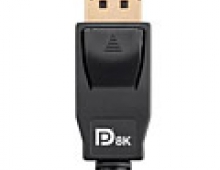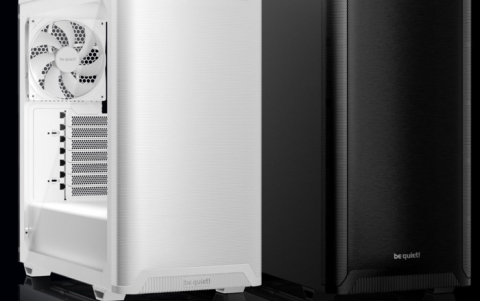
VGA and DVI display standards to be replaced by DisplayPort
VESA is reviewing a new standard scalable, with the capacity for additional lanes to meet the demands of next-gen displays.
DisplayPort will also be capable of carrying audio signals, and it will apparently use a connector small enough to be integrated into thin and light notebooks. However, the tinfoil hat crowd should note that DisplayPort has an optional content protection scheme to ensure a secure display path for copyrighted material.
As reposrted by News.com, Consumers could see PCs, TVs and projectors with brighter pictures and fewer wires if a new technical specification for monitors passes its final test.
The Video Electronics Standards Association, or VESA, is currently reviewing a proposal for a newly developed standard that aims to enable more colors, higher resolutions and higher refresh rates, as well as simplify the way computers connect to LCD, plasma, CRT and projection displays.
The specification, called DisplayPort, lets high-quality audio share the same cables as video signals and allows for data transfer rates of up to 10.8 gigabits per second using a total of four lanes. That's fewer lanes than many current cable interfaces.
Picture quality is improved with DisplayPort, VESA member Bill Lempesis said, because the specification allows for higher bandwidth and refreshes images instead of reloading them, which makes for better performance on the screen.
"Eventually, the new standard is designed to replace DVI (digital visual interface) and VGA (video graphics array) connectors, which have been around for many years," Lempesis said.
VGA and DVI connectors are those multi-pin ports in the back of PCs and other electronics devices. VESA complains that the VGA connector takes up a lot of real estate on a computer and was not designed for high-definition content. The DVI interface supports high-definition television but does not allow for interactive communication between devices like DisplayPort would, Lempesis said.
ATI Technologies, Dell, Genesis Microchip, Hewlett-Packard, Molex Incorporated, Nvidia, Royal Philips Electronics, Samsung Electronics and Tyco Electronics drafted the DisplayPort specifications in May and submitted them to VESA for approval as a standard earlier this week.
VESA is an international nonprofit representing hardware, software, PC, display and component manufacturers, as well as cable and telephone companies and service providers. VESA members will now review the interface submission and provide a forum where companies can submit future revisions. Lempesis estimates that the review process could take VESA six months or less to complete, meaning consumers could see DisplayPort-compatible devices by next year.
However, Paul Semenza, an analyst with iSuppli, is critical of another unified standard.
"With DisplayPort, there are going to be problems of adapting to legacy connections," Semenza said, noting that previous standards have stood the test of time so far and are not being replaced by emerging ones like DVI and HDMI (High Definition MultiMedia Interface).
DisplayPort includes specifications on display connections, including interfaces between a PC and monitor or projector, a PC and TV or a device such as a DVD player and TV display.
The specification improves on low-voltage differential signal, or LVDS, designs, Lempesis said. That cuts back on the wires laptop computers need to connect to their local LCDs.
The standard also paves the way for optional content protection, which is not automatically part of the standard, Lempesis said. Instead, a module could be added by manufacturers to prevent unauthorized content from being viewed on the display--a feature surely to be a hit in Hollywood.
If approved, the DisplayPort specification would become an industry standard. But it would not necessarily be initially adopted by electronics manufacturers, Semenza said, because it would involve redesigning monitors, as well as the computers they may be plugged into.
Even if companies like Dell, HP, Samsung and Philips do start installing new connectors based on the DisplayPort specification, Semenza said the majority of consumers will probably wait until their next computer upgrade to make the switch.
A similar situation emerged in 1998 when consumers were initially hesitant to adopt a transition from CRT to LCD screens.
As reposrted by News.com, Consumers could see PCs, TVs and projectors with brighter pictures and fewer wires if a new technical specification for monitors passes its final test.
The Video Electronics Standards Association, or VESA, is currently reviewing a proposal for a newly developed standard that aims to enable more colors, higher resolutions and higher refresh rates, as well as simplify the way computers connect to LCD, plasma, CRT and projection displays.
The specification, called DisplayPort, lets high-quality audio share the same cables as video signals and allows for data transfer rates of up to 10.8 gigabits per second using a total of four lanes. That's fewer lanes than many current cable interfaces.
Picture quality is improved with DisplayPort, VESA member Bill Lempesis said, because the specification allows for higher bandwidth and refreshes images instead of reloading them, which makes for better performance on the screen.
"Eventually, the new standard is designed to replace DVI (digital visual interface) and VGA (video graphics array) connectors, which have been around for many years," Lempesis said.
VGA and DVI connectors are those multi-pin ports in the back of PCs and other electronics devices. VESA complains that the VGA connector takes up a lot of real estate on a computer and was not designed for high-definition content. The DVI interface supports high-definition television but does not allow for interactive communication between devices like DisplayPort would, Lempesis said.
ATI Technologies, Dell, Genesis Microchip, Hewlett-Packard, Molex Incorporated, Nvidia, Royal Philips Electronics, Samsung Electronics and Tyco Electronics drafted the DisplayPort specifications in May and submitted them to VESA for approval as a standard earlier this week.
VESA is an international nonprofit representing hardware, software, PC, display and component manufacturers, as well as cable and telephone companies and service providers. VESA members will now review the interface submission and provide a forum where companies can submit future revisions. Lempesis estimates that the review process could take VESA six months or less to complete, meaning consumers could see DisplayPort-compatible devices by next year.
However, Paul Semenza, an analyst with iSuppli, is critical of another unified standard.
"With DisplayPort, there are going to be problems of adapting to legacy connections," Semenza said, noting that previous standards have stood the test of time so far and are not being replaced by emerging ones like DVI and HDMI (High Definition MultiMedia Interface).
DisplayPort includes specifications on display connections, including interfaces between a PC and monitor or projector, a PC and TV or a device such as a DVD player and TV display.
The specification improves on low-voltage differential signal, or LVDS, designs, Lempesis said. That cuts back on the wires laptop computers need to connect to their local LCDs.
The standard also paves the way for optional content protection, which is not automatically part of the standard, Lempesis said. Instead, a module could be added by manufacturers to prevent unauthorized content from being viewed on the display--a feature surely to be a hit in Hollywood.
If approved, the DisplayPort specification would become an industry standard. But it would not necessarily be initially adopted by electronics manufacturers, Semenza said, because it would involve redesigning monitors, as well as the computers they may be plugged into.
Even if companies like Dell, HP, Samsung and Philips do start installing new connectors based on the DisplayPort specification, Semenza said the majority of consumers will probably wait until their next computer upgrade to make the switch.
A similar situation emerged in 1998 when consumers were initially hesitant to adopt a transition from CRT to LCD screens.




















